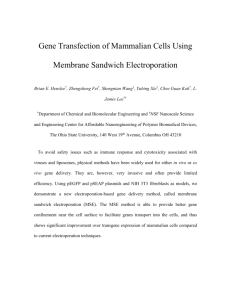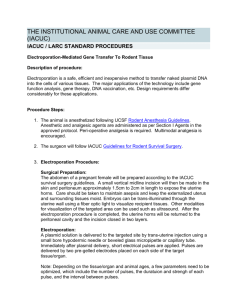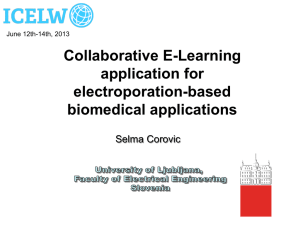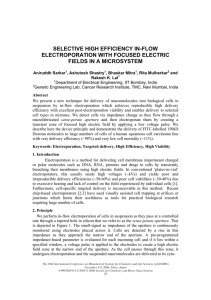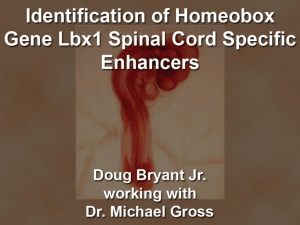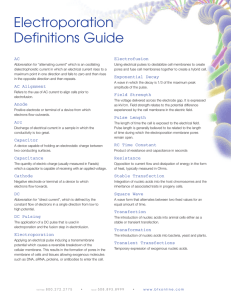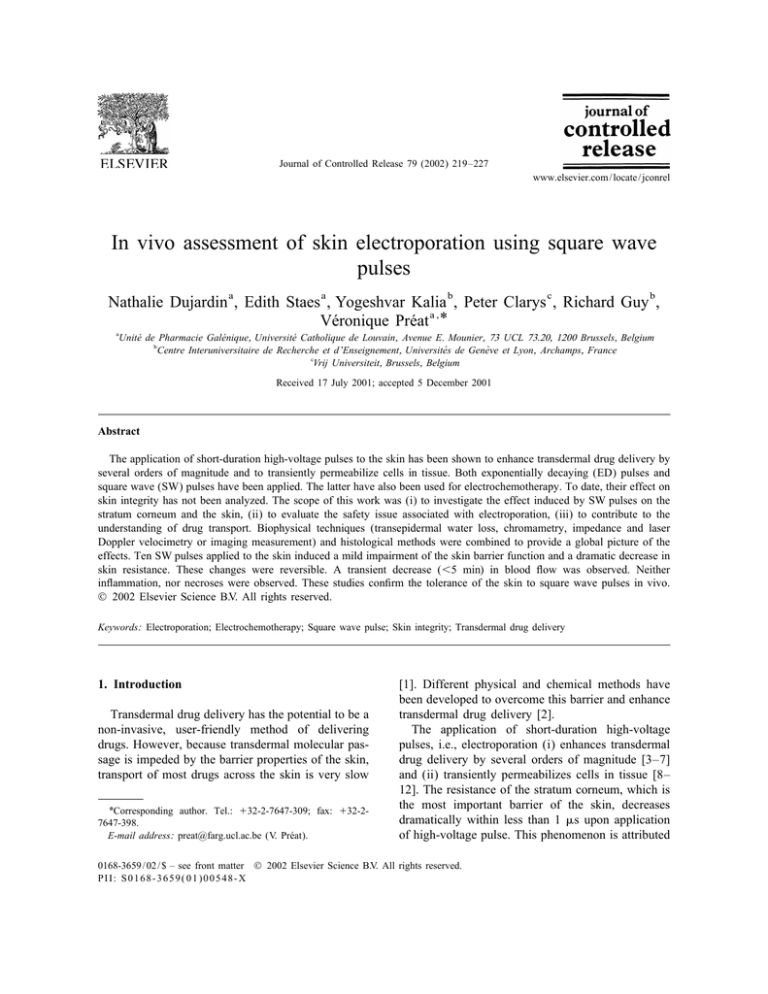
Journal of Controlled Release 79 (2002) 219–227
www.elsevier.com / locate / jconrel
In vivo assessment of skin electroporation using square wave
pulses
Nathalie Dujardin a , Edith Staes a , Yogeshvar Kalia b , Peter Clarys c , Richard Guy b ,
´
´ a ,*
Veronique
Preat
a
´
, Universite´ Catholique de Louvain, Avenue E. Mounier, 73 UCL 73.20, 1200 Brussels, Belgium
Unite´ de Pharmacie Galenique
b
´ de Geneve
` et Lyon, Archamps, France
Centre Interuniversitaire de Recherche et d’ Enseignement, Universites
c
Vrij Universiteit, Brussels, Belgium
Received 17 July 2001; accepted 5 December 2001
Abstract
The application of short-duration high-voltage pulses to the skin has been shown to enhance transdermal drug delivery by
several orders of magnitude and to transiently permeabilize cells in tissue. Both exponentially decaying (ED) pulses and
square wave (SW) pulses have been applied. The latter have also been used for electrochemotherapy. To date, their effect on
skin integrity has not been analyzed. The scope of this work was (i) to investigate the effect induced by SW pulses on the
stratum corneum and the skin, (ii) to evaluate the safety issue associated with electroporation, (iii) to contribute to the
understanding of drug transport. Biophysical techniques (transepidermal water loss, chromametry, impedance and laser
Doppler velocimetry or imaging measurement) and histological methods were combined to provide a global picture of the
effects. Ten SW pulses applied to the skin induced a mild impairment of the skin barrier function and a dramatic decrease in
skin resistance. These changes were reversible. A transient decrease (,5 min) in blood flow was observed. Neither
inflammation, nor necroses were observed. These studies confirm the tolerance of the skin to square wave pulses in vivo.
2002 Elsevier Science B.V. All rights reserved.
Keywords: Electroporation; Electrochemotherapy; Square wave pulse; Skin integrity; Transdermal drug delivery
1. Introduction
Transdermal drug delivery has the potential to be a
non-invasive, user-friendly method of delivering
drugs. However, because transdermal molecular passage is impeded by the barrier properties of the skin,
transport of most drugs across the skin is very slow
*Corresponding author. Tel.: 132-2-7647-309; fax: 132-27647-398.
´
E-mail address: preat@farg.ucl.ac.be (V. Preat).
[1]. Different physical and chemical methods have
been developed to overcome this barrier and enhance
transdermal drug delivery [2].
The application of short-duration high-voltage
pulses, i.e., electroporation (i) enhances transdermal
drug delivery by several orders of magnitude [3–7]
and (ii) transiently permeabilizes cells in tissue [8–
12]. The resistance of the stratum corneum, which is
the most important barrier of the skin, decreases
dramatically within less than 1 ms upon application
of high-voltage pulse. This phenomenon is attributed
0168-3659 / 02 / $ – see front matter 2002 Elsevier Science B.V. All rights reserved.
PII: S0168-3659( 01 )00548-X
220
N. Dujardin et al. / Journal of Controlled Release 79 (2002) 219 – 227
to electroporation that involves the creation of
transient aqueous pathways by the applied electrical
pulses [13,14].
Several studies have investigated the morphological changes or integrity of the skin after exponentially decaying pulses in vitro or in vivo [15,16]. An
extended study [Freeze-Fracture electron Microscopy
(FFEM), impedance, Fourier transform infrared
spectroscopy (FT-IR), X-ray, Differential Thermal
Analysis (DTA)] was performed to provide a complete picture of the stratum corneum structure after
high voltage pulse application in vitro. Electroporation was reported to induce (i) a disorganisation of
the stratum corneum lipid bilayers; (ii) an increase in
skin hydration; (iii) a decrease in skin resistance
induced by electroporation. These changes were
partly reversible [16,17]. Multilamellar vesicles were
observed in the intercellular lipid bilayers of the
stratum corneum [18]. These studies were supplemented by non-invasive bioengineering methods
in vivo. Transient increase in TEWL (transepidermal
water loss) was associated with an enhancement in
skin hydration and alteration in stratum corneum
barrier function. Reversible increase in cutaneous
blood flow measured by laser Doppler velocimetry
(LDV) and an erythema evaluated by chromametry
was also observed [19]. Dramatic decrease in skin
resistance or impedance has been reported by many
authors (for a review, see Ref. [13]) but to date,
there have been no measurements of skin impedance
in vivo either during or after pulsing.
Besides transdermal drug delivery, another in vivo
application
of
electroporation
is
electrochemotherapy, a new therapeutic approach providing
delivery into the cell interiors of non-permeant
drugs, which have intracellular targets. After intravenous (i.v.) or local injection of a non-permeant
drug, e.g., bleomycin, which has a high intrinsic
cytotoxicity, local application of short and intense
high voltage pulses permeabilize exposed cells.
Preclinical trials have shown the efficacy of this new
therapeutic modality in various tumor models. Clinical trials have demonstrated its efficacy for the local
treatment of cancers. The pulses seem to be well
tolerated by patients [20,21].
Both exponentially decaying (ED) pulses and
square wave (SW) pulses have been used. In contrast
to ED pulses, SW pulses can be set at constant
predetermined values of voltage and pulse length.
They have been used in clinical trials of electrochemotherapy and are being investigated for transdermal delivery of macromolecules. To date, their
effect on skin integrity has not been analysed.
The scope of this work was: (i) to investigate the
effect induced by high-voltage pulse application used
for transdermal drug delivery and for electrochemotherapy (SW pulses) on the stratum corneum
and the skin, (ii) to evaluate the safety associated
with electroporation and (iii) to contribute to the
understanding of transdermal drug transport. Noninvasive biophysical methods to assess barrier function (TEWL, impedance) and cutaneous blood flow
[LDV, Laser Doppler Imaging (LDI), dye diffusion],
were combined with histology to provide a global
picture of the effects.
2. Materials and methods
2.1. Animals and chemicals
Hairless male rats’ 8 weeks old were housed in
standard cages at room temperature (IOPS mutant
from Iffa Credo, France). Standard laboratory food
(A04, UAR-France) and water were given ad libitum.
Salts for buffer preparation were analytical grade
(Merck Eurolab, Belgium).
2.2. Rat treatment
Experiments were carried out in an assigned
laboratory room with controlled temperature (20 8C)
and relative humidity (30%). Animals were anesthetized before experiments and if necessary, before
a measurement session with Thalamonal (Fentanyl,
50 mg / ml, Droperidol 2.5 mg / ml; Janssen Pharmaceutica, Belgium). A fold of skin was clamped
into a custom built clip. The clip was composed of
two compartments each containing a platinum electrode with an area of 1 cm 2 (99.99% purity, Aldrich,
Belgium). The electrodes were at the outer surface of
each compartment (not in contact with the skin). The
distance between the two electrodes was 6 mm. Both
compartments were filled with 100 ml phosphate
buffer, pH 7.4 (10 mM). No shift in pH was
observed after pulsing. The electrodes were con-
N. Dujardin et al. / Journal of Controlled Release 79 (2002) 219 – 227
nected to the electroporation device Cytopulse PA4000 (CytoPulse Sciences, MD, USA) for application of pulses. Cytopulse PA-4000 delivers square
wave electric field pulses of variable voltage and
duration. During a pulse, the electrical signal was
monitored with an oscilloscope (Model 54602B,
Hewlett-Packard). The voltage and current were
measured directly.
Two pulsing protocols were applied: (i) 10 pulses
of 1000 V (applied voltage) of 100 ms duration
(1031000 V—100 ms) and (ii) 10 pulses of 335 V,
each with a duration of 5 ms [9,22]. Pulsing caused
slight muscle twitches in the rat. Phosphate buffer
solution was in contact with the skin for 5 min
before and after the electrical treatment (except for
impedance measurement, only contact for 5 min
before the electrical treatment). A passive diffusion,
consisting in applying the clip filled with phosphate
buffer for 5 or 10 min, was performed in the control
animals. The measures were performed immediately
following the electroporation.
TEWL was measured using a Tewameter TM 210
(Germany). The probe was maintained in contact
with the skin for 1 min in order to obtain stable
TEWL value, the measurement being taken during
the last 30-s period. Each measurement (expressed in
g / m 2 h) is the result of the average of the registered
values during the last 30 s.
Impedance was measured according the method
described by Kalia et al. [23]. Briefly, the electrical
circuit used for making the impedance measurements
includes a 2 MV resistor in series with the skin. A
Macintosh (Apple Computers), equipped with Lab
View was used to control a HP8116A Pulse / Function Generator (Hewlett-Packard). A frequency of 1
Hz and an applied voltage of 1.0 V (peak to peak)
were used, resulting in a approximately constant
current (|0.25 mA). The potential difference across
the skin was measured using a Stanford Research
Systems 850 DSP lock-in amplifier. All data were
analysed using the Microsoft Excel (version 97)
software package. The impedance values were normalized with respect to initial pre-electroporation
measurement.
221
laser Doppler velocimeter (Periflux, PF3, Perimed,
Sweden). The probe was placed directly on the skin
and maintained in contact for at least 1 min. The
values were recorded when a constant signal was
observed. Each data point (expressed in 10 2 Hz) is
the result of three measurements.
LDI was used immediately after electroporation to
visualize the blood flow under the electrodes and in
the surrounding tissue. The moving blood cells from
the upper 300 mm give rise to a shift in the
backscattered light which is directly proportional to
skin blood perfusion. The LDI system developed by
Moor Instruments (Axminster, UK) is a computercontrolled system that uses a low-power He–Ne laser
to scan the tissue. The Doppler components are
detected and processed to generate an output signal
(within 0–10 V) that is linearly proportional to tissue
blood perfusion. When all measurement values have
been captured and stored by the system, a colorcoded image is displayed on the monitor [24].
One minute after electroporation, a dye injection
of 1 ml of a solution containing 50 mg / ml of patent
violet blue (Sigma, Belgium) in saline was injected
i.v. The distribution of dye in the electroporated and
non-electroporated sites was compared. A decrease
in blood flow is characterized by a delay in the
appearance of dye in the skin whereas an increased
blood flow is characterized by a more intense blue
color of the skin [25].
2.4. Histology
To assess the effect of electroporation on the skin
structure, skin samples submitted to high voltage
pulses in vivo were fixed in formaldehyde (Merck,
Germany) and eosin–hematoxylin stained.
2.5. Statistics
The data were validated by the Dixon test. Dunnet’s tests were used to compare the different
treatments at each time (P,0.05).
3. Results
2.3. Blood flow
Cutaneous blood flow was determined using a
The aim of this paper was to investigate the effect
of square wave pulses on the stratum corneum and
N. Dujardin et al. / Journal of Controlled Release 79 (2002) 219 – 227
222
the skin. Hence, a number of different methods were
used in order to provide a global understanding of
the effect of electroporation on the skin. The impedance and TEWL evaluated the barrier function of
the skin, LDV, LDI and patent blue staining investigated the cutaneous blood flow. The histology assessed skin integrity.
the 1000 or 335 V protocol, TEWL returned to basal
values within 35 min (P.0.05 at this time) (Fig. 2).
These data indicate that SW pulses induce a transient
impairment of the barrier function of the skin as
already pointed out by the impedance measurements.
3.3. Blood flow
3.1. Impedance
Electroporation induces a dramatic decrease in
skin resistance, which recovers partially in vitro
[26,27]. Previous studies have not investigated the
recovery of skin after electroporation in vivo. Normalized impedance values decreased significantly
after pulsing as compared to a control site. Impedance value returned to control values within 6 h
following the 103(1000 V—100 ms) protocol application. However, following the 103(335 V—5 ms)
treatment, the impedance values took longer to return
to the pre-electroporation values (Fig. 1).
3.2. TEWL
A significant increase in TEWL was observed
following each electrical treatment. The highest
enhancements occurred directly after treatment (at 7
min after electroporation, P,0.05). Following either
Several methods were used to evaluate the cutaneous microcirculation. LDI indicates that the blood
flow was strongly decreased straight after pulse
application. The blood circulation was similar to the
circulation in the skin surrounding the electrodes
within 5 min for 335 V (Fig. 3) and 10 min for the
1000 V protocol (data not shown). These data were
confirmed by the dye injection method. A similar
decrease in blood circulation was detected. The
diffusion of the dye in the skin observed approximately 1 min after patent blue injection was delayed
at the electroporated site. It increased progressively
to reach a color equivalent to surrounding tissue
within 6 and 9 min after application of the 335 and
1000 V pulses, respectively.
LDV did not show any modification in blood flow
from 7 min to 78 h after electroporation (Fig. 4).
No modification of the redness was observed by
chromametry (parameter a*) (data not shown).
Fig. 1. Relative impedance value after sham control (DP), 103(335 V—10 ms) or 103(1000 V—100 ms). N56.
N. Dujardin et al. / Journal of Controlled Release 79 (2002) 219 – 227
223
Fig. 2. TEWL (g / m 2 h) after skin electrical treatment. Measurements at the cathode, anode and control sites. N56.
3.4. Histological studies
No significant histological changes were detected
in the skin subjected to electroporation in vivo.
Neither inflammation nor necroses were detected
after 5 min, 1, 2, 4 or 7 days after electroporation
(Fig. 5).
4. Discussion
The scope of this work was: (i) to investigate the
effect induced by square wave high-voltage pulse
application used for transdermal drug delivery and
for electrochemotherapy on the stratum corneum and
the skin, (ii) to evaluate their safety and (iii) to
contribute to the understanding of transdermal drug
transport. Typical electroporation conditions used for
transdermal drug delivery or electrochemotherapy
were used in this study (for reviews, see Refs.
[11,15]).
The effects induced by SW pulses on the skin
were relatively mild and reversible.
First, since electroporation is known to induce cell
death, we checked if electroporation induced cell
death in the skin in vivo. Cell viability as measured
by MTT test was not affected. No necrosis or
inflammations were observed in histological sections
of the skin [28].
These data indicate that the SW pulses used did
not induce major cell damage in the skin and suggest
that under the experimental conditions used, electroporation permeabilizes the keratinocytes [28–30]
or superficial tumor cells [21] without affecting skin
viability in vivo. Nevertheless, ultrastructural
changes of the stratum corneum, e.g., a disorganisation of the lipid bilayers [17] and the formation of
water vesicles [18] are induced by electroporation.
224
N. Dujardin et al. / Journal of Controlled Release 79 (2002) 219 – 227
Fig. 3. LDI maps and histograms of blood perfusion in the skin of rat’s abdomen 1 min 30 s (A) and 8 min (B) after 103(335 V—5 ms).
Control (C) 3 min 30 s after clipping the buffered skin. N53.
Secondly, the effect of the SW pulses on skin
microcirculation was evaluated by different techniques. The data indicate that the blood flow is
transiently decreased for a period of 5 min but
subsequently recovers and in some cases is slightly
increased later on. A similar blockage of circulation
was observed by Mir and co-workers in other tissue
such as the liver and the muscle [11,25]. Such a
decrease in blood flow could be positive for electrochemotherapy in order to prevent the loss of a
cytotoxic drug injected directly in the tumor.
Whether this blood circulation blockage can affect
transdermal drug delivery is still unknown.
Thirdly, SW pulses induced a transient impairment
N. Dujardin et al. / Journal of Controlled Release 79 (2002) 219 – 227
225
Fig. 4. LDV (10 2 Hz) after skin electrical treatment. Measurements at the cathode, anode and control sites. N56.
of the barrier function of the skin. The dramatic
decrease in skin impedance reported in all the papers
dealing with in vitro skin electroporation [13,26] was
also observed in vivo. It is linked with the mechanism of electroporation, which is believed to create
new aqueous pathways in the stratum corneum. Skin
impedance is an indirect measure of small ion
transport. Its decrease indicates an enhanced skin
permeability towards ions. Even though high voltage
pulses dramatically lowered skin impedance, normal
impedance values were achieved within 6 or 24 h,
indicating relatively rapid recovery of the increased
skin permeability. Similarly, TEWL increased at
both the cathode and anode sites after SW pulses.
The primary increase in TEWL resulted from water
accumulation in the skin and from the electrical
treatment itself [17,19]. The TEWL values returned
rapidly to basal values. The perturbation of the
barrier function of the skin can contribute to the
transdermal transport of drug by increasing the
penetration by passive diffusion through a permeabilized skin [31].
The effect of two electroporation protocols [103
(335 V—5 ms) and 103(1000 V—100 ms)] were
compared. The modification of the barrier function
and the effect on the blood flow were higher for the
335 V protocol than the 1000 V protocol. The higher
energy applied and the higher number of charge
transferred for the 335 V protocol can easily explain
this. Comparison of the SW pulses with the exponentially decaying pulses is difficult because electroporation conditions were different. However, similar
findings were reported: a mild and transient impairment of the barrier function measured by TEWL and
an erythema.
Using different complementary techniques, we
studied the effect of SW pulses on the skin. A mild
impairment of the skin barrier function, a decrease in
226
N. Dujardin et al. / Journal of Controlled Release 79 (2002) 219 – 227
Acknowledgements
The authors thank Cytopulse for the electroporation device, Dr. D. Boggetts from Moor Instruments
Ltd., for the laser Doppler imaging and FRSM
(Belgium) for the financial support.
References
Fig. 5. Hematoxylin–eosin stained slides of control skin (A) and
skin 4 days after electroporation 103(1000 V—100 ms) (B).
skin resistance and a transient decrease in blood flow
were induced by electroporation. These changes
were reversible and did not alter the viability of the
skin. Even though perturbations of the skin were
observed, these data confirm the tolerance of the skin
to square wave pulses in vivo as suggested by
clinical practices showing that the patients submitted
to electrochemotherapy tolerate well the 1000 V
protocol [20].
[1] J. Hadgraft, R. Guy, Transdermal Drug Delivery, Development Issues and Research Initiatives, Marcel Dekker, New
York, 1989.
[2] C.S. Asbill, El. Kattan, B. Michniak, Enhancement of
transdermal drug delivery: chemical and physical approaches, Crit. Rev. Ther. Drug Carr. Syst. 17 (6) (2000)
621–658.
[3] M.R. Prausnitz, V.G. Bose, R. Langer, J.C. Weaver, Electroporation of mammalian skin: a mechanism to enhance
transdermal drug delivery, Proc. Natl. Acad. Sci. USA 90
(1993) 10504–10508.
´ Transdermal delivery
[4] R. Vanbever, N. Lecouturier, V. Preat,
of metoprolol by electroporation, Pharm. Res. 11 (1994)
1657–1662.
[5] J.E. Riviere, N.A. Monteiro-Riviere, R.A. Rogers, D. Bommannan, J.A. Tamada, R.O. Potts, Pulsatile transdermal
delivery of LHRH using electroporation: drug delivery and
skin toxicology, J. Control. Release 36 (1995) 229–233.
´ J.C. Weaver, Comparison
[6] R. Vanbever, U.F. Pliquett, V. Preat,
of the effects of short, high-voltage and long, medium
voltage pulses on skin electrical and transport properties, J.
Control. Release 69 (1999) 35–47.
´ Transdermal delivery of
[7] C. Lombry, N. Dujardin, V. Preat,
macromolecules using skin electroporation, Pharm. Res. 17
(1) (2000) 32–37.
[8] A.V. Titomirov, S. Sukharev, E. Kistanova, In vivo electroporation and stable transformation of skin cells of new-born
mice by plasmid DNA, Biochem. Biophys. Acta 1088 (1991)
131–134.
[9] R. Heller, M. Jaroszeski, A. Atkin, D. Moradpour, R. Gilbert,
J. Wands, C. Nicolau, In vivo gene electroinjection and
expression in rat liver, FEBS Lett. 389 (3) (1996) 225–228.
[10] T. Nishi, K. Yoshizato, S. Yamashiro, H. Takeshima, K. Sato,
K. Hamada, I. Kitamura, T. Yoshimura, H. Saya, J. Kuratsu,
Y. Ushio, High-efficiency in vivo gene transfer using intraarterial plasmid DNA injection following in vivo electroporation, Cancer Res. 56 (5) (1996) 1050–1055.
[11] L.M. Mir, M.F. Bureau, J. Gehl, R. Rangara, D. Rouy, J.M.
Caillaud, P. Delaere, D. Brannelec, B. Shwartz, D. Scherman,
High efficiency gene transfer into skeletal muscle mediated
by electric pulses, Proc. Natl. Acad. Sci. USA 96 (8) (1999)
4262–4267.
´ Mechanisms of
[12] V. Regnier, N. De Morre, A. Jadoul, V. Preat,
N. Dujardin et al. / Journal of Controlled Release 79 (2002) 219 – 227
[13]
[14]
[15]
[16]
[17]
[18]
[19]
[20]
[21]
[22]
a phosphorothioate oligonucleotide delivery by skin electroporation, Int. J. Pharm. 184 (1999) 147–156.
U. Pliquett, Mechanistic studies of molecular transdermal
transport due to skin electroporation, Adv. Drug Deliv. Rev.
35 (1999) 41–60.
J. Weaver, T. Vaughan, Y. Chizmadzhev, Theory of electrical
creation of aqueous pathways across skin transport barriers,
Adv. Drug Deliv. Rev. 35 (1999) 21–39.
´
R. Vanbever, V. Preat,
In vivo efficacy and safety of skin
electroporation, Adv. Drug Deliv. Rev. 35 (1999) 77–88.
´ Effects of iontophoresis and
A. Jadoul, J. Bouwstra, V. Preat,
electroporation on the stratum corneum. Review of the
biophysical studies, Adv. Drug Deliv. Rev. 35 (1999) 89–
105.
´
´ ElecA. Jadoul, H. Tanajo, V. Preat,
F. Spies, H. Bodde,
troperturbation of human stratum corneum fine structure by
high voltage pulses: a freeze fracture electron microscopy
and differential thermal analysis study, J. Invest. Dermatol.
Symp. Proc. 3 (1998) 153–158.
S. Gallo, A. Sen, M. Hensen, S. Hui, Time-dependent
ultrastructural changes to porcine stratum corneum following
and electric pulse, Biophys. J. 76 (1999) 2824–2832.
´
R. Vanbever, D. Fouchard, A. Jadoul, N. De Morre, V. Preat,
J.-P. Marty, In vivo non-invasive evaluation of hairless rat
skin after high-voltage pulse exposure, Skin Pharmacol.
Appl. Skin Physiol. 11 (1998) 23–34.
´ C. Domenge,
´ D.
L.M. Mir, L.F. Glass, G. Sersa, J. Teissie,
Miklavcic, M.J. Jaroszeski, S. Orlowski, D.S. Reintgen, Z.
Rudolf, M. Belehradek, R. Gilbert, M.P. Rols, J. Belehradek,
J.M. Bachaud, R. DeConti, B. Stabuc, M. Cemazar, P.
Coninx, R. Heller, Effective treatment of cutaneous and
subcutaneous malignant tumours by electrochemotherapy,
Br. J. Cancer 77 (12) (1998) 2336–2342.
R. Heller, R. Gilbert, M.J. Jaroszeski, Clinical applications
of electrochemotherapy, Adv. Drug Deliv. Rev. 35 (1999)
119–129.
M.P. Rols, C. Delteil, M. Golzio, P. Dumond, S. Cros, J.
[23]
[24]
[25]
[26]
[27]
[28]
[29]
[30]
[31]
227
´ In vivo electrically mediated protein and gene
Teissie,
transfer in murine melanoma, Nat. Biotechnol. 16 (2) (1998)
168–171.
Y.N. Kalia, L.B. Nonato, R.H. Guy, The effect of iontophoresis on skin barrier integrity: non-invasive evaluation
by impedance spectroscopy and transepidermal water loss,
Pharm. Res. 13 (6) (1996) 957–960.
C. Anderson, T. anderson, K. Wardell, Changes in skin
circulation after insertion of a microdialysis probe visualized
by laser Doppler perfusion imaging, J. Invest. Dermatol. 102
(5) (1994) 807–811.
J. Gehl, T.H. Sorensen, K. Nielsen, P. Rasmark, S.L. Nielsen,
T. Skovsgaard, L.M. Mir, In vivo electroporation of skeletal
muscle: threshold, efficacy and relation to electric field
distribution, Biochim. Biophys. Acta 1428 (2–3) (1999)
233–240.
U. Pliquett, R. Langer, J.C. Weaver, Changes in the passive
electrical properties of human stratum corneum due to
electroporation, Biochim. Biophys. Acta 1239 (1995) 111–
121.
´ V. Preat,
´ Transdermal delivery
R. Vanbever, E. LeBoulenge,
of fentanyl by electroporation I. Influence of electrical
factors, Pharm. Res. 13 (4) (1996) 559–565.
´
N. Dujardin, P. Van Der Smissen, V. Preat,
Topical gene
transfer into rat skin using electroporation, Pharm. Res. 18
(1) (2001) 61–66.
´ Localisation of a FITC-labelled phosV. Regnier, V. Preat,
phorothioate oligodeoxynucleotide in the skin after topical
delivery by iontophoresis and electroporation, Pharm. Res.
15 (1998) 1596–1602.
S. Somiari, J. Glasspool-Malone, J.J. Drabick, R.A. Gilbert,
R. Heller, M.J. Jaroszeski, R.W. Malone, Theory of in vivo
application of electroporative gene delivery, Mol. Ther. 2 (3)
(2000) 178–187.
´
R. Vanbever, N. Morre, V. Preat,
Transdermal delivery of
fentanyl by electroporation II. Mechanisms involved in drug
transport, Pharm. Res. 13 (9) (1996) 1360–1366.

